Portrait of the Young Artist
David Hockney was born on 9 July 1937 in Bradford, West Yorkshire. As a schoolboy, he had a passion for art even before he fully understood what it meant to be an artist. His academic training at Bradford School of Art, which emphasized drawing, painting, and the study of anatomy and perspective, provided the foundation for his career.
The works in this section demonstrate the evolution of Hockney’s practice, built upon his natural aptitude as a draftsman. At the Royal College of Art in London, where he enrolled in 1959, Hockney threw himself into life classes. In 1960, a Picasso retrospective at the Tate marked the beginning of a fascination with the modern master, whose eclecticism was a formative influence on the young artist.
Although homosexuality remained illegal in England until 1967, Hockney took up overtly gay themes in his work at the Royal College before almost anyone else. In A Rake’s Progress, a personal narrative of his first trip to the United States in the summer of 1961—influenced by the eighteenth-century print series by William Hogarth—Hockney’s sense of his own identity began to emerge.
Artwork: © David Hockney
Self-Portrait, 1954
 The self-portraits Hockney made in his teenage years, such as the present one and the pencil drawings nearby, convey a youthful confidence as well as the beginnings of an intense self-scrutiny. The full-frontal pose and attention to detail in clothes and styling reflect Hockney’s burgeoning sense of his own identity. This collage also offers a foretaste of Hockney’s later works, notably his vibrant palette and experimentation with different media.
The self-portraits Hockney made in his teenage years, such as the present one and the pencil drawings nearby, convey a youthful confidence as well as the beginnings of an intense self-scrutiny. The full-frontal pose and attention to detail in clothes and styling reflect Hockney’s burgeoning sense of his own identity. This collage also offers a foretaste of Hockney’s later works, notably his vibrant palette and experimentation with different media.
David Hockney
Self-Portrait, 1954
Collage on newsprint
Bradford Museums and Art Galleries, Cartwright Hall
The David Hockney Foundation
© David Hockney
Photography by Richard Schmidt
Self Portrait Study, 1954
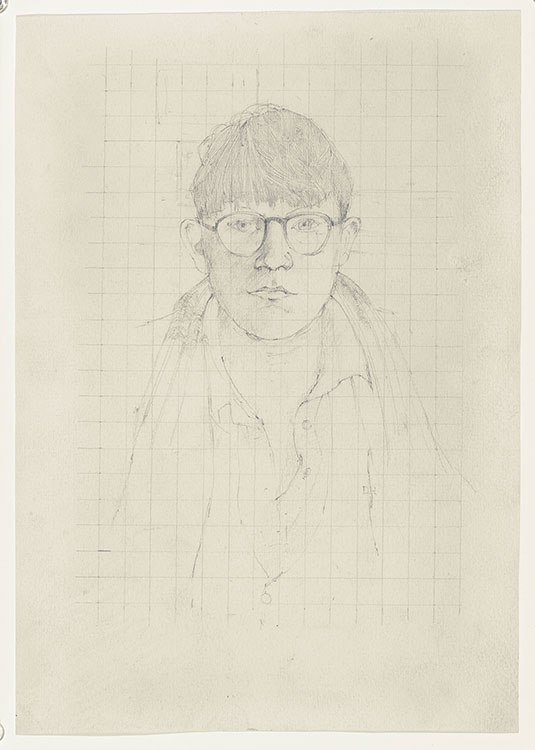
David Hockney
Self Portrait Study, 1954
Pencil on paper
The David Hockney Foundation
© David Hockney
Photography by Richard Schmidt
Self Portrait, 1954

David Hockney
Self Portrait, 1954
Lithograph
The David Hockney Foundation
© David Hockney
Photography by Richard Schmidt
Self Portrait, 1956
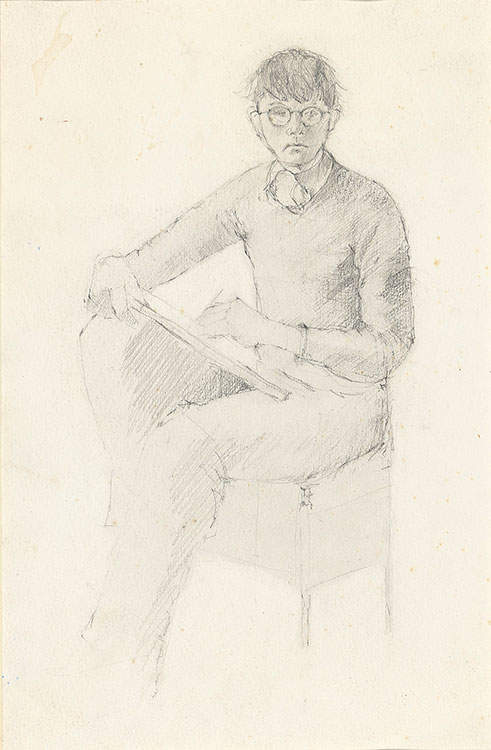
David Hockney
Self Portrait, 1956
Pencil on paper
The David Hockney Foundation
© David Hockney
Photography by Richard Schmidt
My Bonnie Lies over the Ocean
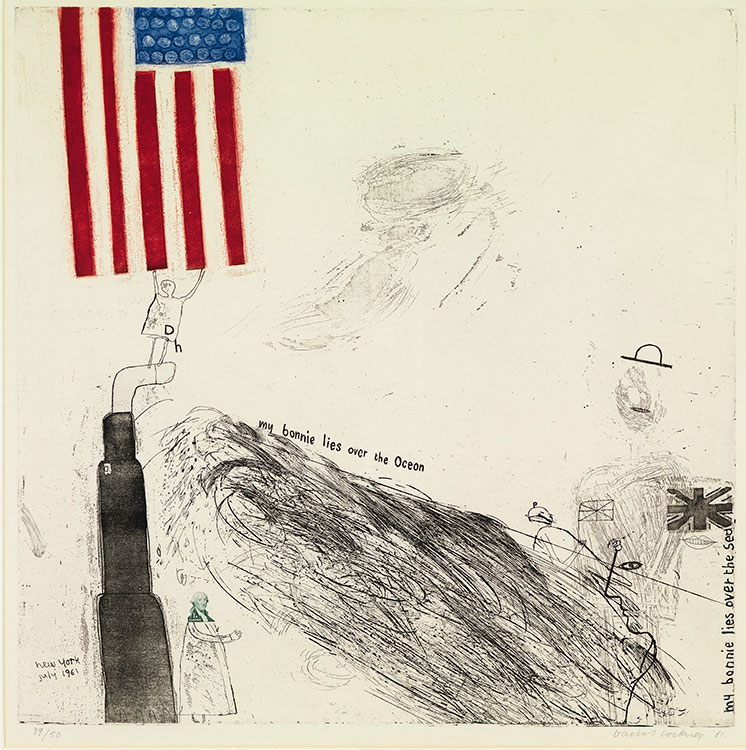
David Hockney
My Bonnie Lies over the Ocean, 1961
Etching and aquatint with collage
Arts Council Collection, Southbank Centre, London
© David Hockney
Photography by Richard Schmidt
Myself and My Heroes

While at the Royal College of Art in London, Hockney turned to etching for pragmatic reasons. Students were responsible for purchasing their own supplies and Hockney had quickly run out of money thanks to his enthusiasm for painting, so he took advantage of the college’s free printmaking materials. His first etching, Myself and My Heroes, embraces several of his passions at the time: the homoerotic poetry of Walt Whitman and the pacifism and vegetarianism of Mahatma Gandhi.
David Hockney
Myself and My Heroes, 1961
Etching in black with aquatint
Victoria and Albert Museum, London
The David Hockney Foundation
© David Hockney
Photography by Richard Schmidt
A Rake’s Progress, 1961–63
Hockney’s first visit to the United States, in the summer of 1961, provided the narrative for this semiautobiographical series. Inspired by William Hogarth’s 1735 engraving series of the same title, Hockney transformed the tale of an aristocrat who squanders his wealth into his own personal story of a young gay man’s journey and emerging identity in 1960s New York City. Although Hockney claimed that “It is not really me. It’s just that I use myself as a model because I’m always around,” the etchings were partly inspired by real events. Plate 1a records his meeting with William S. Lieberman, then curator of drawings and prints at the Museum of Modern Art, who bought two prints from him, including Myself and My Heroes. The name “Lady Clairol” on plate 3 refers to the brand of hair dye Hockney used to bleach his hair for the first time. A range of artistic influences can be traced, from the figures of William Blake to the art brut of Jean Dubuffet.
The Arrival

David Hockney
The Arrival from A Rake's Progress, 1961–1963
Etching
The David Hockney Foundation
© David Hockney
Photography by Richard Schmidt
Receiving the Inheritance

David Hockney
Receiving the Inheritance from A Rake's Progress, 1961–1963
Etching, aquatint
The David Hockney Foundation
© David Hockney
Photography by Richard Schmidt
Meeting the Good People (Washington)
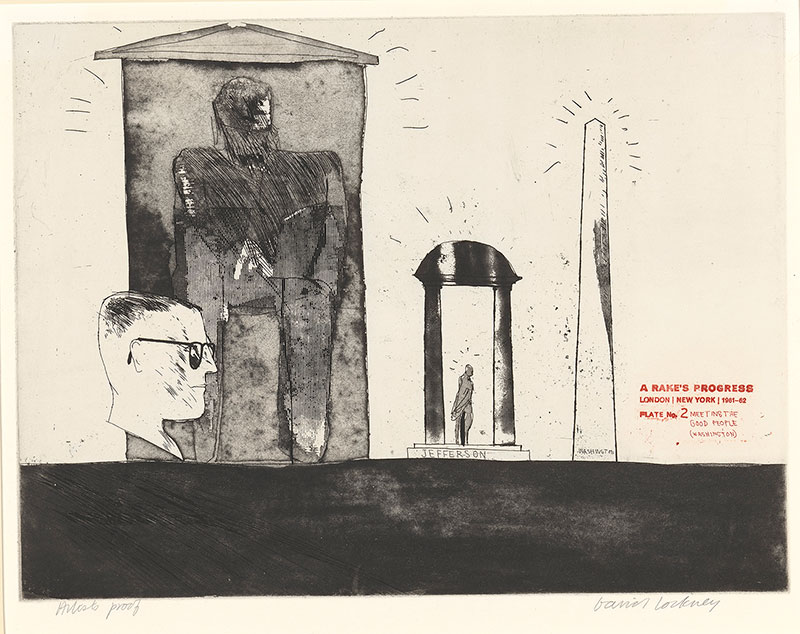
David Hockney
Meeting the Good People (Washington) from A Rake's Progress, 1961–1963
Etching, aquatint
The David Hockney Foundation
© David Hockney
Photography by Richard Schmidt
The Gospel Singing (Good People) Madison Square Garden

David Hockney
The Gospel Singing (Good People) Madison Square Garden, 1961–1963
The David Hockney Foundation
© David Hockney
Photography by Richard Schmidt
The Start of the Spending Spree and the Door Opening for a Blonde
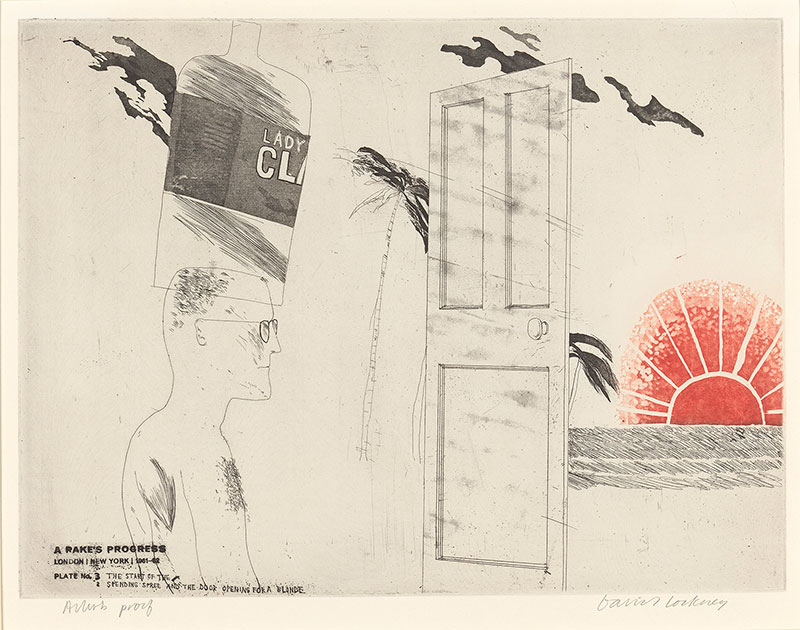
David Hockney
The Start of the Spending Spree and the Door Opening for a Blonde from A Rake's Progress, 1961–1963,
Etching, aquatint
The David Hockney Foundation
© David Hockney
Photography by Richard Schmidt
The Seven Stone Weakling

David Hockney
The Seven Stone Weakling from A Rake's Progress, 1961–1963
Etching, aquatint
The David Hockney Foundation
© David Hockney
Photography by Richard Schmidt
The Drinking Scene
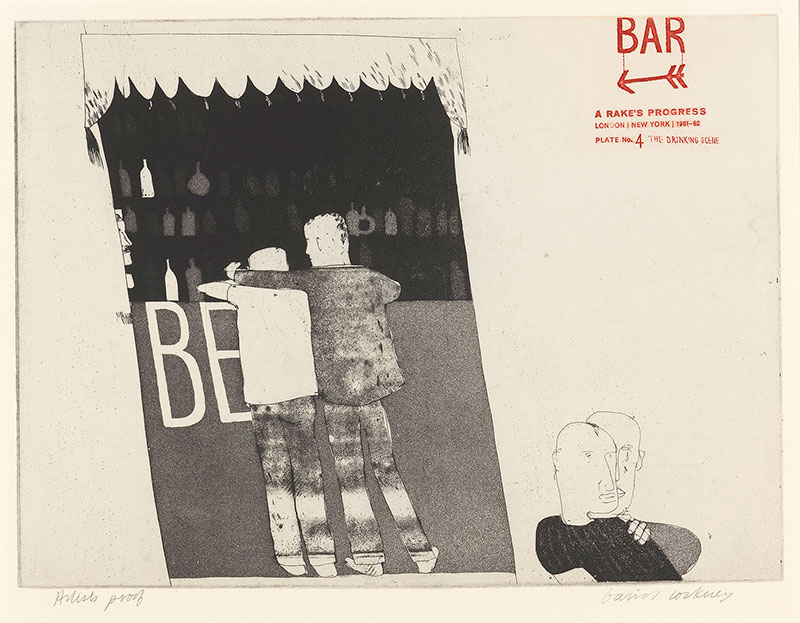
David Hockney
The Drinking Scene from A Rake's Progress, 1961–1963
Etching, aquatint
The David Hockney Foundation
© David Hockney
Photography by Richard Schmidt
Marries an Old Maid
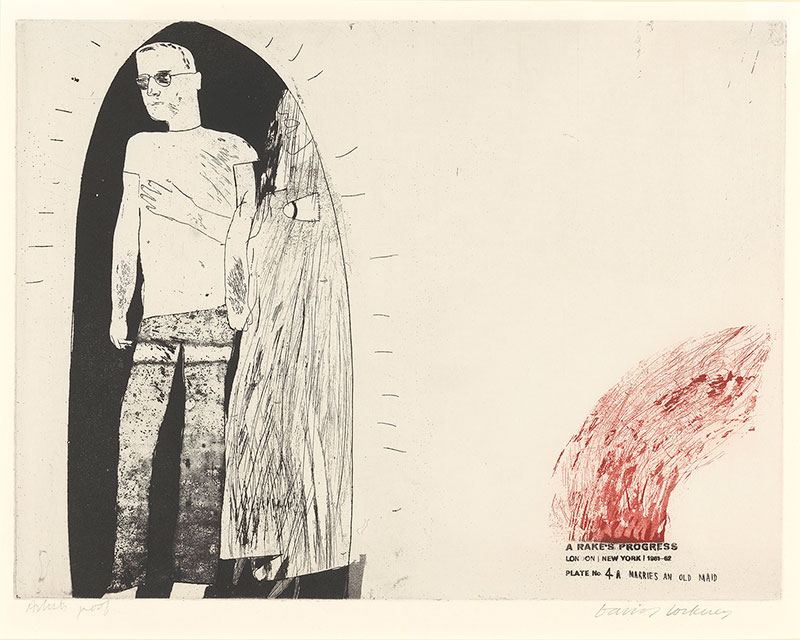
David Hockney
Marries an Old Maid from A Rake's Progress, 1961–1963
Etching, aquatint
The David Hockney Foundation
© David Hockney
Photography by Richard Schmidt
The Election Campaign (with Dark Message)
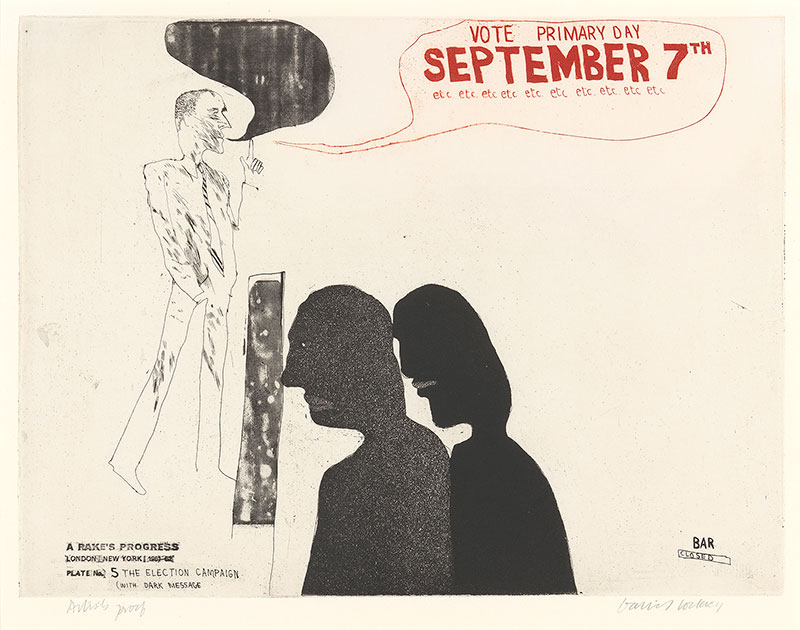
David Hockney
The Election Campaign (with Dark Message) from A Rake's Progress, 1961–1963
Etching, aquatint
The David Hockney Foundation
© David Hockney
Photography by Richard Schmidt
Viewing a Prison Scene

David Hockney
Viewing a Prison Scene from A Rake's Progress, 1961–1963
Etching, aquatint
The David Hockney Foundation
© David Hockney
Photography by Richard Schmidt
Death in Harlem

David Hockney
Death in Harlem from A Rake's Progress, 1961–1963
Etching, aquatint
The David Hockney Foundation
© David Hockney
Photography by Richard Schmidt
The Wallet Begins to Empty

David Hockney
The Wallet Begins to Empty from A Rake's Progress, 1961–1963
Etching, aquatint
The David Hockney Foundation
© David Hockney
Photography by Richard Schmidt
Disintigration

David Hockney
Disintigration from A Rake's Progress, 1961–1963
Etching, aquatint
The David Hockney Foundation
© David Hockney
Photography by Richard Schmidt
Cast Aside

David Hockney
Cast Aside from A Rake's Progress, 1961–1963
Etching, aquatint
The David Hockney Foundation
© David Hockney
Photography by Richard Schmidt
Meeting the Other People
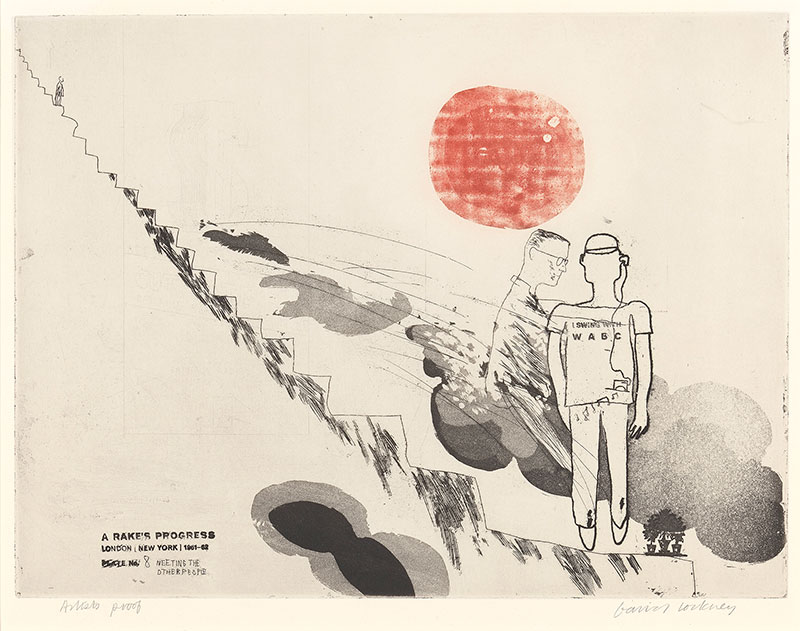
David Hockney
Meeting the Other People from A Rake's Progress, 1961–1963
Etching, aquatint
The David Hockney Foundation
© David Hockney
Photography by Richard Schmidt
Bedlam
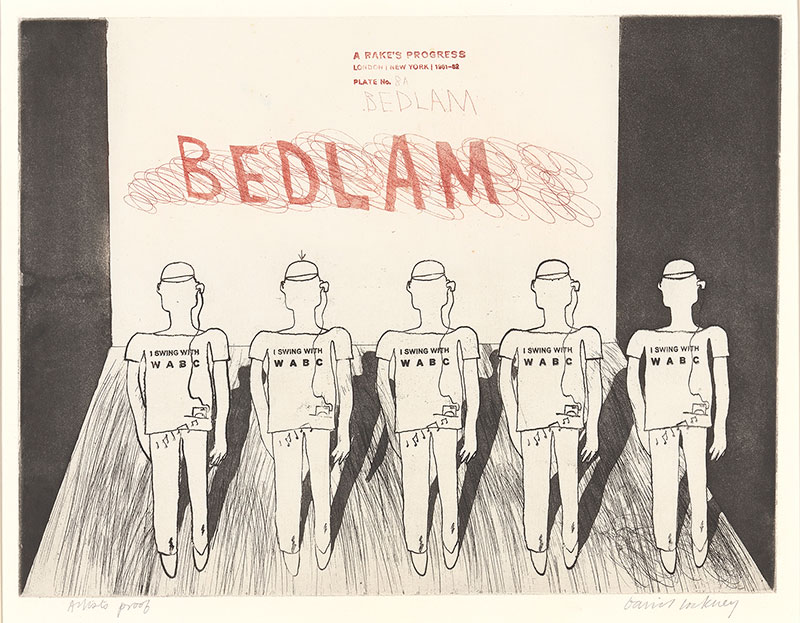
David Hockney
Bedlam from A Rake's Progress, 1961–1963
Etching, aquatint
The David Hockney Foundation
© David Hockney
Photography by Richard Schmidt
The Diploma

David Hockney
The Diploma, 1962
Etching with aquatint
Victoria and Albert Museum, London
© David Hockney
Photography by Richard Schmidt
The Student: Homage to Picasso

David Hockney
The Student: Homage to Picasso, 1973
Etching, soft ground etching, lift ground etching
National Portrait Gallery, London. Purchased, 1979
The David Hockney Foundation
© David Hockney
Photography by Richard Schmidt
Artist and Mode

Following Picasso’s death in April 1973, Hockney made two etchings in the spirit of Picasso’s renowned Vollard Suite (1930−37). In the present one, Hockney depicts an imaginary meeting with the modern master, casting himself as the nude model and using different etching techniques to distinguish the two: for Picasso, the looser “sugar-lift” method—which involves brushing the figure directly on the plate with a sugar-based fluid—and a more densely hatched line for himself. Hockney had been taught the sugar-lift technique that year in Paris by Aldo Crommelynck, the master printer of Picasso’s later etchings.
David Hockney
Artist and Model, 1973–1974
Etching
The David Hockney Foundation
© David Hockney
Photography by Richard Schmidt
